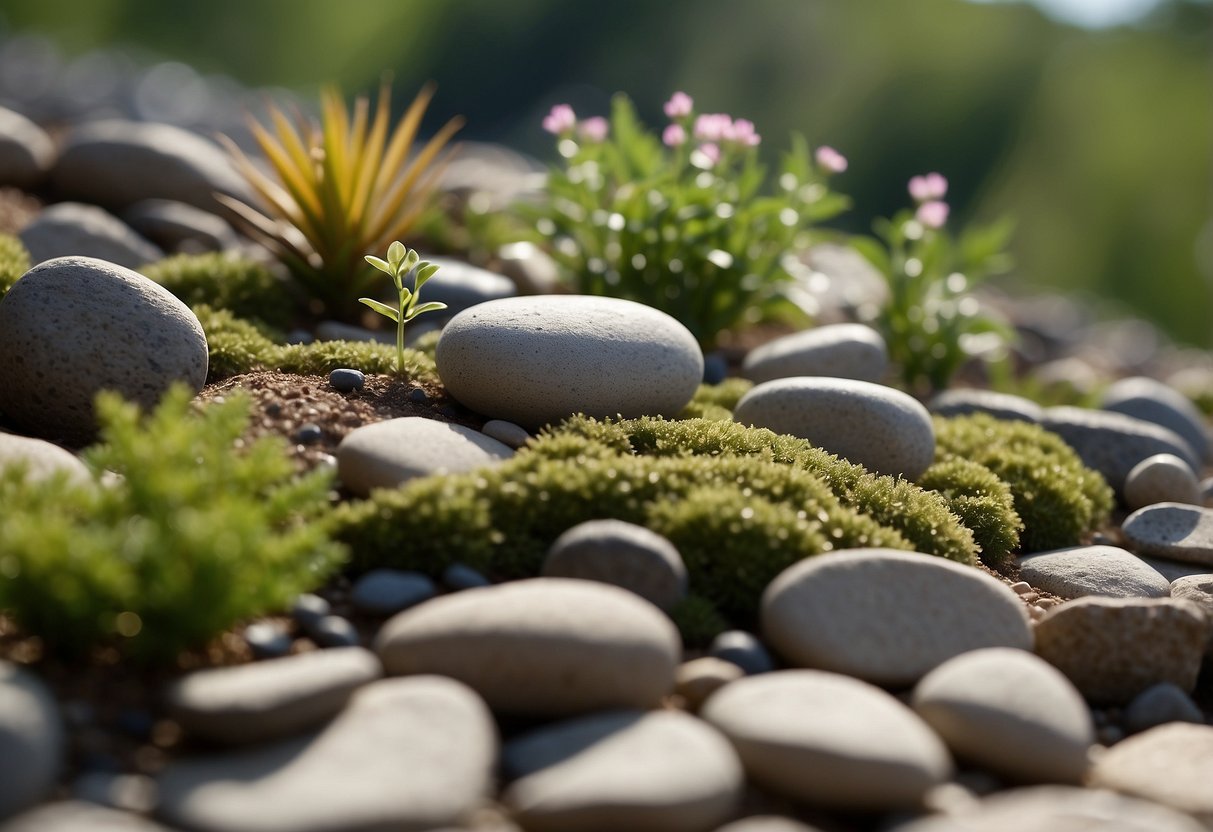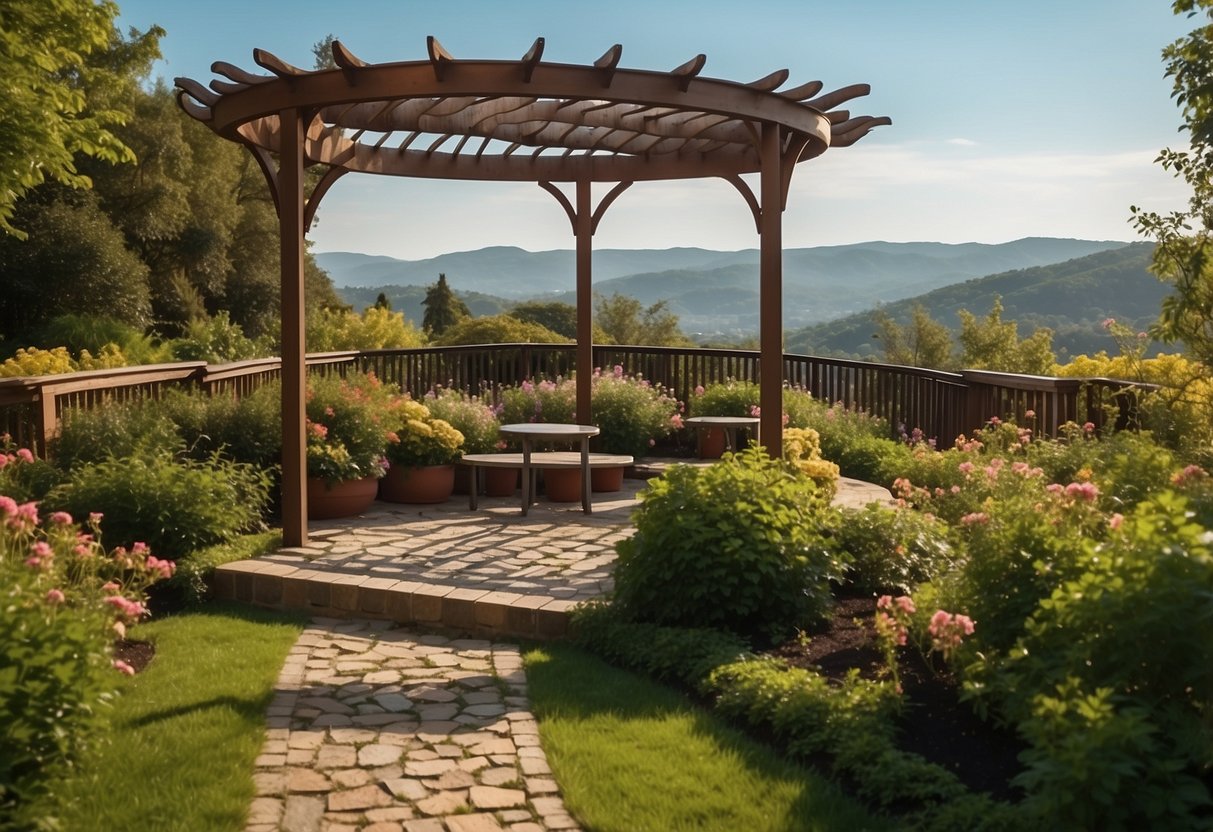Garden Ideas on a Hill: Creative Tips for Sloping Landscapes
Gardening on a hill can turn your sloped backyard into a captivating and functional space. With some creativity and planning, you can transform those challenging inclines into beautiful landscapes that are both practical and pleasing to the eye. By choosing the right plants and incorporating thoughtful design elements, you can create a garden that thrives on a hillside.

Whether you’re into cascading flowers, rock gardens, or cozy patios, the possibilities are endless. Your hillside garden can become a unique and enjoyable part of your home, showcasing your personal style and making the most of the natural landscape.
1) Terraced Garden Beds

Terraced garden beds are perfect for hillsides. By creating multiple levels, you can maximize your planting space. These beds also help with drainage and soil erosion.
You can build terraces using materials like wood, stone, or concrete blocks. Each level can be used to plant different types of flowers, vegetables, or groundcovers.
Make sure to stabilize your terraces well. This ensures they can handle water flow and prevent any structural issues.
2) Staircase Pathways

Staircase pathways can transform your hillside garden into a beautiful and functional space. Building a staircase on a slope involves a few key steps. First, you need to excavate the area and remove any large rocks.
Next, grade and level the surface where each step will be located. Using gravel and wood can create a stable and attractive staircase. This method adds charm and accessibility to your hillside garden.
For a more detailed guide, check out how to build an outdoor staircase.
3) Waterfall Feature

Adding a waterfall to your hill garden can transform it into a relaxing retreat. It’s a great use of natural slopes.
You can build a small, simple waterfall with stacked stones in a corner of the garden. Even if your space is limited, this feature can fit in perfectly.
For larger areas, consider a more dramatic waterfall with a stream flowing down the slope.
4) Rocky Zen Garden

Creating a Rocky Zen Garden on a hillside can bring peace and beauty to your backyard. You can arrange rocks in simple, natural patterns to create a calming space.
By using rounded stones and boulders, you can design pathways or small terraces. This not only looks good but also helps prevent soil erosion.
Adding low-maintenance plants like sedums and creeping thymes can provide your garden with a beautiful and serene look.
5) Container Plants

Using container plants on a hill can simplify your gardening. You can place them at levels that are easy to reach, making maintenance a breeze. They also help prevent soil erosion and runoff.
Choose sturdy containers to withstand hill conditions. Place them on flat surfaces or use terraced steps to keep them stable. Exploring various container garden ideas can add beauty and variety to your hillside garden.
6) Hillside Vegetable Plot

A hillside can be a great place for a vegetable plot. You can use terraces to create flat planting areas, which helps manage water runoff and soil erosion.
Incorporate reinforced beds that run across the slope to stabilize the hillside. This way, you make planting and maintaining your garden easier.
Plant cover crops like clover or rye between your vegetables to keep the soil in place and improve its quality. These plants are good for stopping erosion and adding nutrients.
You can read more about creating a vegetable garden on a slope at GrowVeg.
7) Pergola Overlook

Adding a pergola to your hillside garden can create a stunning viewpoint. Place the pergola where you have the best view. This could be at the top of the hill or on a flat terrace.
Decorate the pergola with climbing plants like roses or wisteria. This will add beauty and shade. Benches or a small table underneath can make it a cozy spot.
Consider pathways leading up to the pergola. Stone or gravel paths are great options and can enhance the natural look. Your hillside garden will be both functional and beautiful with a pergola overlook.
8) Wildflower Meadow

Planting a wildflower meadow on a hill can create a beautiful and natural landscape. Wildflowers like black-eyed Susan, butterfly weed, and wild asters can thrive on a slope and attract many pollinators.
Incorporate various wild grasses to add texture and movement. Choose native plants to ensure they grow well and support the local ecosystem.
Keep the soil moist, especially when seedlings are young, to help them establish. This mix of flowers and grasses can transform your hillside into a vibrant, lively space.
9) Retaining Walls

Retaining walls are a great way to prevent soil erosion on a hill. These structures hold the soil in place and can be made from materials like wood, rock, or concrete blocks.
You can even get creative by using curved concrete blocks for a unique look. This type of wall can enhance your garden’s appearance while serving its practical purpose.
For a lush look, consider planting creeping phlox or other crevice-loving plants between the blocks. This will add a splash of green and make your wall visually appealing.
10) Hanging Planters

Hanging planters are a great way to add beauty to a hillside garden. They create visual interest and save space.
Try using hanging planters to showcase colorful flowers or trailing plants. This adds a lovely touch to any garden.
Consider a two-pot wooden hanging planter to bring some charm to your space. They are functional and stylish.
Understanding Garden Design On A Hill

Designing a garden on a hill presents unique challenges and benefits. Addressing issues like soil erosion and water flow are critical, while the slope can offer visual interest and opportunities for creativity.
Challenges Of Sloped Gardens
Sloped gardens often face erosion issues. Rainwater can wash away soil, making it harder for plants to grow. To combat this, you can plant ground cover plants like creeping phlox or install terraces to stabilize the soil.
Water management is another challenge. Water tends to run off slopes quickly, often causing drainage problems. Consider incorporating features like retaining walls or gentle slopes to help redirect water.
Accessibility can also be a problem. Navigating a sloped garden is tricky, especially for people with mobility issues. You can add paths and stairs to make it easier to move around.
Benefits Of Gardening On A Hill
Despite the challenges, gardening on a hill offers several advantages. A sloped garden provides excellent drainage, which many plants need to thrive. The natural slope helps excess water flow away, preventing root rot.
You can create visually stunning landscapes by taking advantage of the slope. By using terraces, you can grow different plants at different levels, making your garden look more dynamic and interesting.
Sloped gardens also let you implement different design elements. For example, using terracing can transform a steep hill into a series of beautiful, functional areas. Whether you prefer a modern look or a more rustic feel, the possibilities are endless.
Soil And Plant Selection

Selecting the right soil and plants for your sloped garden is crucial. Good soil can aid in preventing erosion, while choosing the right plants will ensure they thrive in your garden’s unique conditions.
Choosing The Right Soil
When gardening on a slope, soil stability is essential. Choose soil that drains well but retains enough moisture to nourish plant roots. Adding organic matter like compost can help improve soil structure and fertility.
Steps to Prepare Your Soil:
- Test Soil pH: Determine if any amendments are needed.
- Add Compost: Enrich soil with nutrients and improve texture.
- Consider Mulch: Use mulch to reduce erosion and retain moisture.
- Check Drainage: Ensure soil isn’t waterlogged, as this can lead to root rot.
Proper soil preparation sets the foundation for a healthy sloped garden.
Best Plants For Sloped Gardens
Selecting the right plants is vital for combating erosion and maintaining soil stability. Opt for plants with deep root systems that help anchor the soil.
Ideal Plants for Sloped Gardens:
- Perennials: Such as daylilies and hostas, which have strong root systems.
- Ground Covers: Like creeping juniper and vinca, which spread quickly and cover soil.
- Shrubs: Including boxwood and dwarf ornamental grasses, which provide structure and prevent runoff.
It’s also important to assess your slope’s sunlight exposure. Some plants require full sun, while others thrive in partial shade.
Using a mix of these plants can create a visually appealing and stable garden. For more ideas, you can explore these garden tips for hillside gardening.
Constructing Garden Tiers

Creating garden tiers on a hillside involves building terraces and using retaining walls to manage soil and water flow. These methods help create flat planting areas that can prevent erosion and make gardening easier.
Building Terraces
Terraces transform a slope into a series of level steps. Begin by measuring the area to determine how many tiers you want. Each tier should be wide enough to allow for planting and maintenance, generally 3-6 feet wide depending on your slope.
Steps to build terraces:
- Measure and stake: Mark your terraces with stakes and string.
- Digging: Dig horizontally into the slope to create flat areas.
- Level: Ensure each terrace is level to prevent water run-off.
- Edge support: Use sturdy materials like wood, stone, or bricks to edge each terrace.
These terraces provide distinct planting areas, and their flatness helps with water absorption and retention.
Using Retaining Walls
Retaining walls are crucial in holding back soil and creating a stable structure for your terraces. Choose materials like stone, bricks, or timber for durability.
Steps to build retaining walls:
- Foundation: Dig a trench and fill it with gravel for drainage.
- First row: Place your first row of retaining wall materials on the gravel.
- Stacking: Continue stacking layers, stepping back slightly with each layer.
- Backfill: As you build, backfill with soil to hold the wall in place.
Retaining walls not only support your garden tiers but also add an aesthetic element to your garden. They help prevent erosion and ensure the stability of the terraces.
By following these steps, you can transform your hillside into a series of productive garden spaces.







